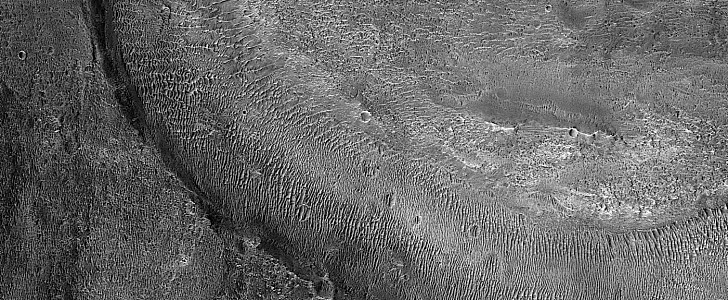Like it probably happens on most other space objects out there, water is no stranger over on Mars. Probably no longer present there in liquid form right now, the stuff has played an important part in shaping the neighboring planet, and probably even in supporting some sort of life forms way back in the past.
If you plan on seeing exactly how water shaped Mars, there’s no better place to go than Margaritifer Terra. Located South of the planet’s Equator, it covers up to 2,600 km (1,616 miles) of space on Mars and is littered with impact craters, chaos terrain, and outflow channels.
The place is also home to Ares Vallis, the place where two Earth missions went, one probably crashing (the Soviet Mars 6 in 1974) and the other, American’s Pathfinder, landing in 1997.
Scientists here on Earth also keep a close eye on the place with the help of the HiRISE orbital camera. The image of Margaritifer Terra shown as the main photo of this piece is probably the most recent one the hardware took, snapped from an altitude of 261 km (162 miles) in May this year.
Released by the University of Arizona, the pic shows a small portion of “the most impressive water-modified landscape on Mars that preserves the highest density of valley networks on the planet.”
Speculation is fluvial activity in the region began at least four billion years ago, but exactly how it unfolded will probably remain a perpetual mystery, despite of the traces left behind, like the fluvial channel shown in the pic.
Recent work conducted by scientists shows liquid water was not some meteoric presence on Mars, but must have played “a huge role in shaping the geology all around the planet.” This conclusion came at the end of ten years of research that led to the discovery of hundreds of thousands of locations holding aqueous minerals, but also clays and salts.
The place is also home to Ares Vallis, the place where two Earth missions went, one probably crashing (the Soviet Mars 6 in 1974) and the other, American’s Pathfinder, landing in 1997.
Scientists here on Earth also keep a close eye on the place with the help of the HiRISE orbital camera. The image of Margaritifer Terra shown as the main photo of this piece is probably the most recent one the hardware took, snapped from an altitude of 261 km (162 miles) in May this year.
Released by the University of Arizona, the pic shows a small portion of “the most impressive water-modified landscape on Mars that preserves the highest density of valley networks on the planet.”
Speculation is fluvial activity in the region began at least four billion years ago, but exactly how it unfolded will probably remain a perpetual mystery, despite of the traces left behind, like the fluvial channel shown in the pic.
Recent work conducted by scientists shows liquid water was not some meteoric presence on Mars, but must have played “a huge role in shaping the geology all around the planet.” This conclusion came at the end of ten years of research that led to the discovery of hundreds of thousands of locations holding aqueous minerals, but also clays and salts.






